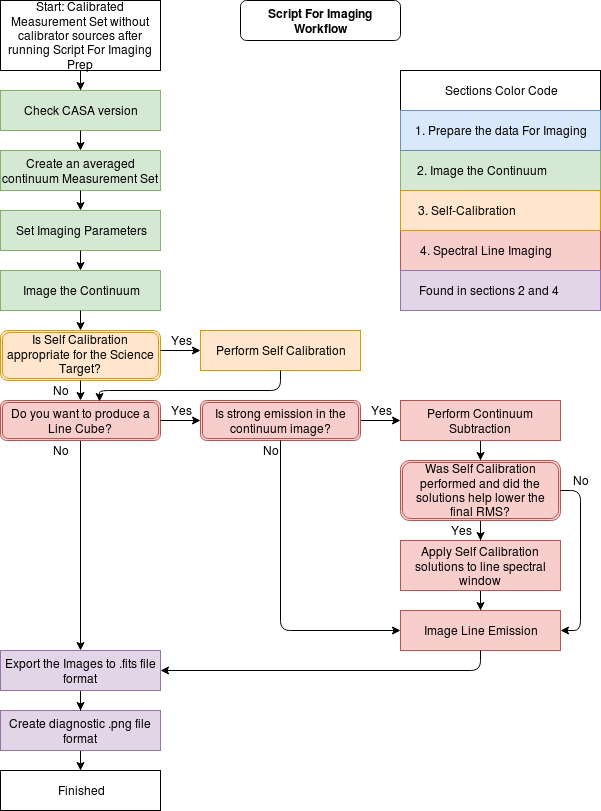Guide to the NA Imaging Template
About this Guide
This guide provides an outline of the Imaging Script followed by the North America ALMA Science Center (NAASC) in producing manually imaged Quality Assurance 2 (QA2) products of interferometric data. This is intended to be used as a template to produce basic continuum and line images. Some sections of this template are only appropriate for certain datasets. Therefore, not all sections of code in this guide may need to be run in order to reach a final product.
The ALMA Imaging Pipeline Reprocessing guide should be used to create pipeline images of delivered data.
All example images were produced using ALMA Science Verification Data of TW Hya. More information along with the dataset can be obtained from the TW Hydra Band 7 Calibration and Imaging Guide.
Prepare for Imaging
Before you begin imaging, it is important to determine whether the data is manually or pipeline calibrated. The README file should state how the dataset was calibrated. If this is not the case, look in the script directory of the delivered data package. If you see a file named <ASDM UID>.ms.scriptForCalibration.py, the dataset was manually calibrated. If you see a filename PPR_<Member OUS UID>.xml, the dataset was pipeline calibrated.
It is recommended that you use the same version of CASA in which the original reduction was performed. Refer to the README file or CASA logs to see which version was used. Download CASA and check for operating system requirements before proceeding.
Instructions on restoring the calibrated measurement set should be found in the README of your delivered dataset. For most cases, this can be done by executing scriptForPI.py in CASA in the script directory.
# in CASA
execfile(“scriptForPI.py”)
Attached Scripts
Two template scripts are available for this guide. These contain commands with minimal directions and are intended to be used by those more familiar with imaging. File:ScriptForImagingPrep Template.py File:ScriptForImaging Template.py
Obtaining Analysis Utilities
Some optional steps in this guide use the Analysis Utilities package. If you wish to use any of these tasks, follow the link above for download and installation instructions.
CASA Basics
If you are new to interferometry or CASA, we recommend you follow the “First Look” Imaging Tutorials. In addition, many frequently asked questions can be found in the ALMA Knowledgebase. If you have additional questions after reviewing this guide, please contact the ALMA Helpdesk.
Guides for Using the North American ALMA Manual Imaging Template
This guide has been split into 4 sections:
- Prepare for Imaging This page creates the calibrated_final.ms that will be used in during imaging. Commands can be found in scriptForImagingPrep_template.py attached to this page.
- Image the Continuum This page creates a continuum measurement set (MS) and continuum images. The MS created in Imaging_Prep is needed for this guide. Commands can be found in scriptForImaging.py attached to this page.
- Self Calibration Template This page provides a basic template for phase and amplitude self calibration of the continuum. The MS created in Image_Continuum is needed for this guide. Commands can be found in scriptForImaging.py attached to this page.
- Spectral Line Imaging This page performs continuum subtraction and creates spectral line cubes. The MS created in Imaging_Prep is needed for this guide. Commands can be found in scriptForImaging.py attached to this page.

The Imaging Workflow gives an outline of possible imaging you may do with the above guides.
How to Use A CASA Guide
For tips on using CASA and ways CASA can be run, see EVLA_Spectral_Line_Calibration_IRC+10216#How_to_Use_This_casaguide page.
To learn how to extract executable Python scripts from the tutorial, see Extracting_scripts_from_these_tutorials.
Within the guides:
# In CASA
Regions of this color are CASA commands (or definitions) that need to be cut and
pasted in sequence. Wait until one command is finished before pasting another.
Tabs matter in python, make sure that commands that span more than one line and
"for" loops keep their spacing. Sometimes (especially "for" loops) you may need to
explicitly hit enter twice to get the command going.
Information in this color shows excerpts from the CASA Logger output
This color shows you background information about the data or other types of reference material